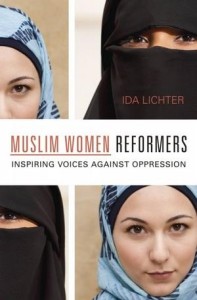|
Reviewed by Jeanette M. Fregulia, Ph.D., Assistant Professor of History, Carroll College Australian psychiatrist Ida Lichter notes on the first page of her book Muslim Women Reformers, Inspiring Voices Against Oppression that since September 11, 2001 much media attention has been devoted to an ideology of political Islam that not only promotes acts of terror, but also espouses a vision of Islam that denies rights to women. In this climate Lichter begins, scant attention has been given to women who challenge this view. With the stated goal of “amplifying their voices” (p. 17), Ida Lichter takes on the task of bringing greater attention to these women in a manner that addresses some of the common challenges they face, while avoiding the temptation to essentialize the women involved or the Muslim faith. Arranging the material alphabetically, the author addresses questions of gender inequality, women’s oppression, and attempts at reform in countries from Afghanistan to the United States. Each section begins with a short description of the contemporary situation for women, efforts at reform, and in three instances (Afghanistan, Iran, and Saudi Arabia), the author provides a broad general assessment. Lichter devotes the remainder of each chapter to short profiles of specific women, including upbringing and family, educational background, profession, and women’s rights organizations with which they are involved as applicable. The book ends with a short section titled “Muslim Male Activists,” as well as a discussion of some of the transnational organizations devoted to promoting gender equality. Despite a formulaic narrative tone, the text does provide a broad overview of the efforts of women reformers. In the course of just over 400 pages, readers are introduced to Safia Amajan of Afghanistan, who operated an underground school for girls, joined the Department of Women’s Affairs in 2001, later rising to its leadership, and was ultimately murdered by the Taliban in 2005 at the age of sixty-three. Other profiles of female activists include Aida Seif el-Dawla of Egypt, who founded the El Nadim Center for the Psychological Rehabilitation of Victims of Violence in 1993, and Wajeha al-Huwaider a journalist in Saudi Arabia, who, along with Fawzia al-Ayouni, is perhaps best known for leading the 2007 campaign to allow women to drive. If the text overall leaves readers wanting a bit more depth, the author should be commended for her efforts not to portray Muslim female reformers as a monolithic group. Varying greatly in terms of religion, culture, family background, educational level, profession, and goals for reform, Lichter is noticeably even-handed, calling attention to both noted Egyptian feminist Ekbal Baraka who argues that “discrimination against women is not an essential part of Islam” (p. 100), and Fatima Mernissi of Morocco who maintains an opposing position, asserting that “equality of the sexes contradicts Islam” (p. 251). The author also asserts that many of the women she highlights favor reforms within the context of Islam, including Ziba Mir-Hosseini of Iran, whose feminism involves “reconciling the Muslim faith with democracy and gender equality” (p. 181). The strengths noted above notwithstanding, the text also has limitations, particularly for those well versed in the subject matter. Specifically, it only skims the surface, offering little new information or analysis on a topic that, as Nikki Keddie notes in Women in the Middle East, Past and Present (2007) has only begun to receive careful study in approximately the last twenty years. To strengthen the volume, as well as make it more appealing to specialists, the author needed to move beyond the series of brief profiles and offer some new insight. The author would have benefited considerably from examining the primary source materials available, rather than relying almost exclusively on media sources including newspaper and magazine articles, reprinted interviews and speeches, and reports from human rights organizations. This secondary material, while useful for providing context and opportunities for further reading, does not allow readers to hear clearly the voices of the individual women. The book would be more compelling and informative if it included, as often as possible, interviews conducted by the author herself, accompanied by an analysis of these personal meetings. Finally, the author provides no formal conclusion, leaving readers to wonder what new insights she gained, what the future might hold for Muslim women and their desire for reforms, and what additional research might yield. Summing up, Muslim Women Reformers offers an interesting and easily accessible introduction to those unfamiliar with the subject. It may, however, prove less useful to specialists in the field. |


 Muslim Women Reformers, Inspiring Voices Against Oppression
Muslim Women Reformers, Inspiring Voices Against Oppression